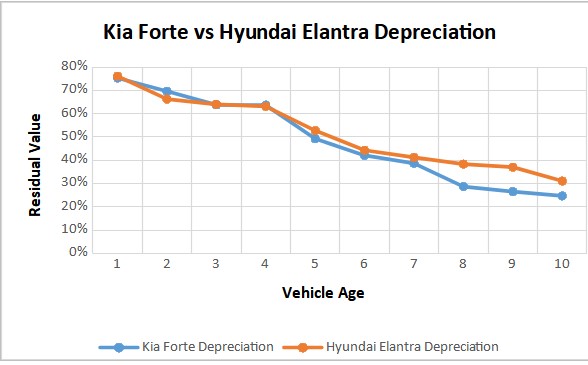Kia vs. Hyundai: Resale Value (8 Models Compared)
Kia and Hyundai are South Korean multinational automobile manufacturing companies. Both are headquartered in Seoul, South Korea. Their combined production is more than 6 million vehicles per year. It might come as a surprise to many of you that Kia is a subsidiary of Hyundai Motor Company.
People often compare Kia vs Hyundai resale value because both cars have the same country of origin. In this article, I will explain which car brand depreciates quicker. Moreover, eight popular models of both brands will be compared.
Kia vs. Hyundai: Resale Value
Both car brands Kia and Hyundai have average performance when it comes to value retention. However, Hyundai has a slightly better resale value than Kia. Though the difference between the two is not significant.
The average depreciation of Kia and Hyundai cars is shown in the following table.
| Vehicle Age | Kia Depreciation | Hyundai Depreciation |
| 1 | 71% | 75% |
| 2 | 66% | 66% |
| 3 | 62% | 64% |
| 4 | 56% | 60% |
| 5 | 49% | 50% |
| 6 | 41% | 44% |
| 7 | 37% | 41% |
| 8 | 34% | 36% |
| 9 | 30% | 34% |
| 10 | 26% | 29% |
After 5 years of operation, Hyundai cars lose half of their value and on the other hand, Kia cars lose 51 percent of their value during the same time. In general, cars from Hyundai cars have 1 to 4 percent better resale value than Kia cars.
Year to year comparison of the depreciation cost of both car brands is shown in the following graph. The orange line represents Hyundai’s average depreciation and it always remains higher than the blue line which represents Kia’s average depreciation.

Hyundai is the third-largest car manufacturer in the world and because of its popularity, Hyundai cars have better resale value. Let’s compare famous Kia and Hyundai car models side by side and see which car model outperforms the other.
Also read: Is Kia Expensive to Maintain? (Exact Costs)
Kia Sorento vs. Hyundai Santa Fe
Kia Sorento depreciates quicker than Hyundai Santa Fe. Right from the first year, Santa Fe has a better resale value than Sorento.
Kia Sorento has an initial selling price of $34,750. Hyundai Santa Fe is a little expensive and has an initial selling price of $35,868.
| Vehicle Age | Kia Sorento Depreciation | Kia Sorento Residual Value | Hyundai Santa Fe Depreciation | Hyundai Santa Fe Residual Value |
| 1 | 65% | $22,640 | 72% | $25,940 |
| 2 | 62% | $21,399 | 67% | $24,085 |
| 3 | 59% | $20,655 | 64% | $23,117 |
| 4 | 53% | $18,251 | 58% | $20,764 |
| 5 | 45% | $15,627 | 50% | $18,038 |
| 6 | 35% | $12,190 | 44% | $15,886 |
| 7 | 30% | $10,547 | 44% | $15,617 |
| 8 | 29% | $10,078 | 40% | $14,483 |
| 9 | 27% | $9,358 | 36% | $12,956 |
| 10 | 21% | $7,412 | 29% | $10,387 |
After just one year Sorento loses 35 percent of its value and Santa Fe only loses 28 percent of the initial value. This trend continues for the residual life of both vehicles. After six years of operation, the difference grows to 13 percent.
Trending Video: How to Easily Bring Back to Life any Old Car Battery and Save Tons of Money (click to watch)
The below graph shows the residual value of both car models against their age.

Kia Sportage vs. Hyundai Tucson
Both car models have similar value retention for most of the years but Hyundai Tucson performs better than Kia Sportage during the fourth, fifth, and sixth years.
The initial selling price of the Kia Sportage is $30,750 and Hyundai Tucson has also a similar initial price of $30,592. Both models perform below average than other cars and lose around 30 percent of their value after just one year.
For a few years in the middle Tucson better holds its value. But at the end of its lifespan, it has a similar resale value as Kia Sportage.
| Vehicle Age | Kia Sportage Depreciation | Kia Sportage Residual Value | Hyundai Tucson Depreciation | Hyundai Tucson Residual Value |
| 1 | 70% | $21,583 | 71% | $21,858 |
| 2 | 68% | $20,962 | 65% | $19,851 |
| 3 | 65% | $20,107 | 63% | $19,273 |
| 4 | 57% | $17,589 | 61% | $18,615 |
| 5 | 45% | $13,770 | 55% | $16,807 |
| 6 | 43% | $13,309 | 48% | $14,721 |
| 7 | 42% | $12,915 | 38% | $11,711 |
| 8 | 39% | $11,946 | 38% | $11,573 |
| 9 | 34% | $10,486 | 36% | $10,882 |
| 10 | 30% | $9,293 | 28% | $8,517 |
The following graph shows the depreciation comparison of Kia Sportage and Hyundai Tucson.

Also read: 3 Best Hyundai for the Money (+Most Reliable Engines)
Kia Optima vs. Hyundai i40
During the first four years, Hyundai i40 has better value retention than Kia Optima but after the first half of the lifespan, i40 depreciates quicker than Optima.
Kia Optima has an initial selling price of $28,355 and the Hyundai i40 is also very close to it with an initial selling price of $28,601. Kia Optima has terrible resale value during the initial years. It loses 38 percent of its value after just one year.
Whereas in the second half it performs better and ends up having a higher resale value than the Hyundai i40.
| Vehicle Age | Kia Optima Depreciation | Kia Optima Residual Value | Hyundai i40 Depreciation | Hyundai i40 Residual Value |
| 1 | 62% | $17,470 | 78% | $22,252 |
| 2 | 56% | $15,777 | 67% | $19,068 |
| 3 | 55% | $15,595 | 61% | $17,318 |
| 4 | 53% | $15,082 | 55% | $15,736 |
| 5 | 51% | $14,436 | 43% | $12,324 |
| 6 | 43% | $12,275 | 42% | $12,121 |
| 7 | 40% | $11,251 | 40% | $11,415 |
| 8 | 38% | $10,866 | 33% | $9,390 |
| 9 | 32% | $9,210 | 27% | $7,779 |
| 10 | 28% | $7,914 | 26% | $7,436 |
The residual value of both car models is compared in the below graph.

Also read: Why are Kias Cheap? Because They’re Unreliable?
Kia Forte vs. Hyundai Elantra
In the start, both car models have a similar depreciation trend but as they approach the end of their lifespan, Kia Forte depreciates quicker than Hyundai Elantra.
The initial selling price of Kia Forte is $21,914 and Hyundai Elantra is a little expensive with an initial selling price of $22,635. Both car models depreciate at the same rate during the first seven years. But Hyundai Elantra outperforms Kia Forte in the second half and has a better resale value by 6 to 10 percent.
| Vehicle Age | Kia Forte Depreciation | Kia Forte Residual Value | Hyundai Elantra Depreciation | Hyundai Elantra Residual Value |
| 1 | 75% | $16,503 | 76% | $17,218 |
| 2 | 70% | $15,246 | 66% | $14,989 |
| 3 | 64% | $13,970 | 64% | $14,486 |
| 4 | 64% | $13,944 | 63% | $14,280 |
| 5 | 49% | $10,786 | 53% | $11,931 |
| 6 | 42% | $9,213 | 44% | $10,018 |
| 7 | 39% | $8,465 | 41% | $9,319 |
| 8 | 29% | $6,281 | 38% | $8,671 |
| 9 | 27% | $5,810 | 37% | $8,375 |
| 10 | 25% | $5,397 | 31% | $7,026 |
The depreciation trend of both car models is shown in the following graph.

References:
en.wikipedia.org, caredge.com, kia.com, hyundai.com, statista.com, laxmihyundai.com, investopedia.com






